Solar eclipse of September 12, 2072
| Solar eclipse of September 12, 2072 | |
|---|---|
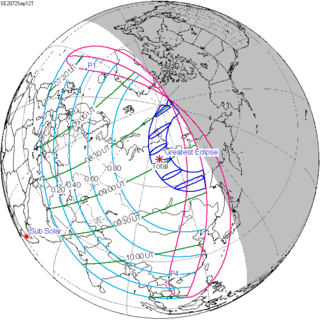 Map | |
| Type of eclipse | |
| Nature | Total |
| Gamma | 0.9655 |
| Magnitude | 1.0558 |
| Maximum eclipse | |
| Duration | 193 sec (3 m 13 s) |
| Coordinates | 69°48′N 102°00′E / 69.8°N 102°E |
| Max. width of band | 732 km (455 mi) |
| Times (UTC) | |
| Greatest eclipse | 8:59:20 |
| References | |
| Saros | 155 (9 of 71) |
| Catalog # (SE5000) | 9670 |
A total solar eclipse will occur on September 12, 2072. A solar eclipse occurs when the Moon passes between Earth and the Sun, thereby totally or partly obscuring the image of the Sun for a viewer on Earth. A total solar eclipse occurs when the Moon's apparent diameter is larger than the Sun's, blocking all direct sunlight, turning day into darkness. Totality occurs in a narrow path across Earth's surface, with the partial solar eclipse visible over a surrounding region thousands of kilometres wide.
This is the first of 55 central eclipses of Solar Saros 155. The first will be in 2072 and the last will be in 3046. This is the first of 56 umbral eclipses of Solar Saros 155. The first will be in 2072 and the last will be in 3064.
The total phase of eclipse will be only in Siberia in Russia. Large cities, in which the total phase will be seen, include Yakutsk, Neryungri, Mirny in Sakha Republic and Khatanga in Krasnoyarsk Krai (also Norilsk will have 98% sun obscuration). As a partial, the eclipse will seen mostly in Europe (except for south of Europe), mostly in Asia and on the east of Greenland.
Related eclipses[]
Solar eclipses 2069–2072[]
This eclipse is a member of a semester series. An eclipse in a semester series of solar eclipses repeats approximately every 177 days and 4 hours (a semester) at alternating nodes of the Moon's orbit.[1]
| 120 | April 21, 2069 Partial |
125 | October 15, 2069 Partial |
| 130 | April 11, 2070 Total |
135 | October 4, 2070 Annular |
| 140 | March 31, 2071 Annular |
145 | September 23, 2071 Total |
| 150 | March 19, 2072 Partial |
155 | September 12, 2072 Total |
Saros 155 series[]
It is a part of Saros cycle 155, repeating every 18 years, 11 days (223 synodic months), contains 71 events. The series started with a partial solar eclipse on June 17, 1928. It has total eclipses from September 12, 2072 to August 30, 2649. The series also has 3 hybrid eclipses from September 10, 2667 to October 3, 2703 and 20 annular eclipses from October 13, 2721 to May 8, 3064.
The series ends at member 71 as a partial eclipse on . The longest total eclipses will be on and on , at 4 minutes and 5 seconds.[2]
| Series members 1–10 occur between 1901 and 2100: | ||
|---|---|---|
| 1 | 2 | 3 |
 June 17, 1928 |
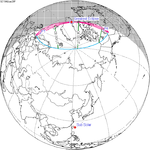 June 29, 1946 |
 July 9, 1964 |
| 4 | 5 | 6 |
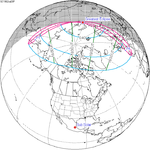 July 20, 1982 |
 July 31, 2000 |
 August 11, 2018 |
| 7 | 8 | 9 |
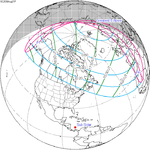 August 21, 2036 |
 September 2, 2054 |
 September 12, 2072 |
| 10 | ||
 September 23, 2090 | ||
Metonic series[]
The metonic series repeats eclipses every 19 years (6939.69 days), lasting about 5 cycles. Eclipses occur in nearly the same calendar date. In addition, the octon subseries repeats 1/5 of that or every 3.8 years (1387.94 days). All eclipses in this table occur at the Moon's ascending node.
| 21 eclipse events, progressing from south to north between July 1, 2000 and July 1, 2076 | ||||
|---|---|---|---|---|
| July 1–2 | April 19–20 | February 5–7 | November 24–25 | September 12–13 |
| 117 | 119 | 121 | 123 | 125 |
 July 1, 2000 |
 April 19, 2004 |
 February 7, 2008 |
 November 25, 2011 |
 September 13, 2015 |
| 127 | 129 | 131 | 133 | 135 |
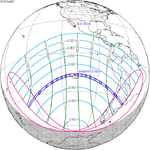 July 2, 2019 |
 April 20, 2023 |
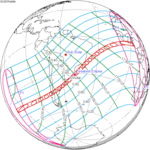 February 6, 2027 |
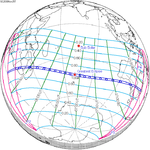 November 25, 2030 |
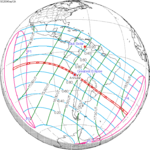 September 12, 2034 |
| 137 | 139 | 141 | 143 | 145 |
 July 2, 2038 |
 April 20, 2042 |
 February 5, 2046 |
 November 25, 2049 |
 September 12, 2053 |
| 147 | 149 | 151 | 153 | 155 |
 July 1, 2057 |
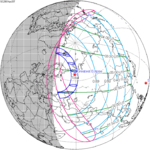 April 20, 2061 |
 February 5, 2065 |
 November 24, 2068 |
 September 12, 2072 |
| 157 | 159 | 161 | 163 | 165 |
 July 1, 2076 |
||||
Notes[]
- ^ van Gent, R.H. "Solar- and Lunar-Eclipse Predictions from Antiquity to the Present". A Catalogue of Eclipse Cycles. Utrecht University. Retrieved 6 October 2018.
- ^ Saros Series Catalog of Solar Eclipses NASA Eclipse Web Site.
References[]
- Earth visibility chart and eclipse statistics Eclipse Predictions by Fred Espenak, NASA/GSFC
- Total solar eclipses
- 2072 in science
- 21st-century solar eclipses
- Future solar eclipses
- Solar eclipse stubs


